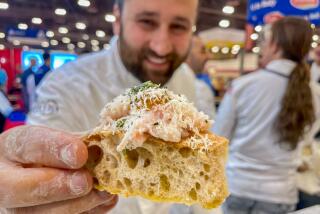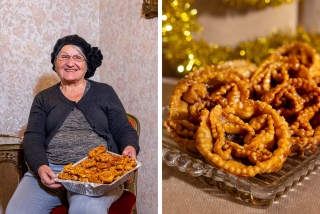Nancy Silverton makes a cheese-filled Focaccia di Recco for Chi Spacca diners
When the focaccia emerges from the oven at Chi Spacca, it resembles a blistered and bubbly moonscape. Cheese bubbles up between gashes in the thin, crackling crust. I take a bite: This may be the single best thing I’ve put in my mouth all year. It tastes of olive oil, salt and tangy molten cheese all at once.
This isn’t the typical bready focaccia from Liguria, but a very particular version from Recco, a little hill town near Genoa. The focaccia is the result of two years’ research by Nancy Silverton and Chi Spacca chef Chad Colby. “But we really got serious about it last November,” Silverton says.
It all started when Mario Batali, Silverton’s partner in the Mozza restaurant group, told her she absolutely had to try focaccia di Recco when she was in Liguria. So she found Recco on the coast east of Genoa, went into a bakery and tried a piece of focaccia.
OK, but not exactly worth a detour. Then someone there told her, “Oh, no, you have to try it at Manuelina’s. That’s the place.”
She did and Manuelina’s focaccia di Recco was unlike any other focaccia she’d ever tried. She pressed the kitchen there for details, learned that the dough is just flour, water, olive oil and salt. It tastes a little like matzoh because it’s unleavened. To make it, the dough is stretched over a table like strudel, thin enough to read the newspaper through. And the cheese is an aged stracchino.
Back in L.A., Silverton tried to make the foccacia again and again and just couldn’t replicate it. So when Colby was going to Italy, she sent him on a mission to find out what kind of pan Manuelina’s used. It turned out to be heavy-gauge copper, hand-hammered in Piedmont, Italy. She ordered a bunch from the same company.
That made a difference, but the dough still wasn’t crisp enough on the bottom. She tried the wood-burning oven. No. Then through her daughter, Vanessa, who knew someone at Modernist Cuisine in Seattle, she found out about a heavy-gauge baking steel that radiated more heat than a typical baking stone. She got hold of one and baking the crust at 500-plus degrees in a deck oven on top of the baking steel did the trick.
Next she had to find the right cheese. She asked her local mozzarella supplier, Di Stefano, to make the cow’s milk cheese stracchino for the focaccia, but his was consistently too wet. She couldn’t describe what she wanted accurately enough so the next time one of her staff went to Italy, she had someone bring a sample of the exact cheese so Di Stefano could see what the texture should be. His solution? A salted, fermented mozzarella that mimics the Italian stracchino’s taste and texture.
After making the focaccia hundreds of times over, once each one of these elements was in place -- the dough, the pan, the oven, the cheese -- Silverton had her focaccia and she’s now proudly serving it every night at Chi Spacca.
“The simplest things are always the hardest,” she says. Evidently.
Now I’m completely obsessed with focaccia di Recco, too, eating it at Chi Spacca every chance I get. It needs wine, cool white wine, namely a carafe of Punta Crena Mataòssu made from a local, almost extinct grape, which sommelier Eduardo Bolaños discovered on his trip to Liguria.
ALSO:
Bellini season: 2 ingredients for a perfect summer drink
Cola-flavored wine for a younger audience: it’s come to this?
Eat your crickets: Los Angeles is the chapulin capital of the U.S.
Twitter: @sirenevirbila
More to Read
Eat your way across L.A.
Get our weekly Tasting Notes newsletter for reviews, news and more.
You may occasionally receive promotional content from the Los Angeles Times.










